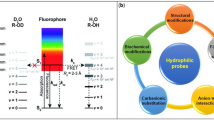Abstract
The photophysical behaviour and excited state decay kinetics of the fluorescent probe Nile red were used for quantitative monitoring of micropolarity, microviscosity and the sol—gel transition temperature of a copolymer hydrogel, pluronic F127. There was considerable enhancement of the emission intensity with a large blue shift in emission and an absorption maximum at and above the sol—gel transition temperature (20 °C), showing the sensitivity of Nile red fluorescence to the sol—gel transition. The estimation of micropolarity by comparing the Nile red emission maximum in dioxane—water mixtures suggested a considerable decrease in the polarity of the PF127 microenvironment from less polar (20% dioxane—water) in its sol phase to almost non-polar (90% dioxane—water) microenvironments in the gel phase. The thermotropic response of the wavelength dependent fluorescence lifetime of the probe with a rise time in the longer wavelength region has enabled monitoring of the microheterogeneity of the gel medium. With an increase in temperature, the microviscosity progressively increases from ∼10 mPa s (sol state) to ∼23 mPa s (gel state). The mismatch between microviscosity as estimated by the Nile red and the corresponding bulk viscosity reflected the microheterogeneity of the pluronic medium and its sensitivity towards PF127 microenvironments.
Similar content being viewed by others
References
A. Y. Jee, S. Park, H. Kwon and M. Lee, Excited state dynamics of nile red in polymers, Chem. Phys. Lett., 2009, 477, 112–115.
M. M. G. Krishna, Excited-state kinetics of the hydrophobic probe nile red in membranes and micelles, J. Phys. Chem. A, 1999, 103, 3589–3595.
A. Cser, K. Nagy and L. Biczok, Fluorescence lifetime of Nile Red as a probe for the hydrogen bonding strength with its microenvironment, Chem. Phys. Lett., 2002, 360, 473–478.
N. Ghoneim, Photophysics of Nile red in solution steady state spectroscopy, Spectrochim. Acta, Part A, 2000, 56, 1003–1010.
A. G. Gilani, M. Moghadama and M. S. Zakerhamidi, Solvatochromism of Nile red in anisotropic media, Dyes Pigm., 2012, 92, 1052–1057.
R. Saxena, S. Shrivastava, S. Haldar, A. S. Klymchenko and A. Chattopadhyay, Location, dynamics and solvent relaxation of a nile red-basedphase-sensitive fluorescent membrane probe, Chem. Phys. Lipids, 2014, 183, 1–8.
I. N. Kurniasih, H. Liang, P. C. Mohr, G. Khot, J. P. Rabe and A. Mohr, Nile red dye in aqueous surfactant and micellar solution, Langmuir, 2015, 31, 2639–2648.
C. Lin, J. Zhao and R. Jiang, Nile red probing for the micelle-to-vesicle transition of AOT in aqueous solution, Chem. Phys. Lett., 2008, 464, 77–81.
B. Chu and Z. Zhou, Physical Chemistry of Polyoxyalkylene Block Copolymer Surfactants, NonionicSurfactants: Polyoxyalkylene Block Copolymer Studies, Marcel-Dekker, Inc., NY, 1996, vol. 60.
A. V. Kabanov, E. V. Batrakova and V. Y. Alakhov, Pluronic block copolymers as novel polymer therapeutics for dug and gene delivery, J. Controlled Release, 2002, 82, 189–212.
Z. Sezgin, N. Yüksel and T. Baykara, Preparation and characterization of polymeric micelles for solubilization of poorly soluble anticancer drugs, Eur. J. Pharm. Biopharm., 2006, 64, 261–268.
E. V. Batrakova and A. V. Kabanov, Pluronic block copolymers: evolution of drug delivery concept from inert nanocarriers to biological response modifiers, J. Controlled Release, 2008, 130, 98–106.
S. Toughraï, V. Malinova, R. Masciadri, S. Menon, P. Tanner, C. Palivan, N. Bruns and W. Meier, Reduction-sensitive amphiphilic triblock copolymers self-assemble into stimuli-responsive micelles for drug delivery, Macromol. Biosci., 2015, 15, 481–489.
J. R. Lakowicz, Principles of Fluorescence Spectroscopy, Kluwer Academic, Plenum Publishers, New York, 2006.
S. Selvam, A fluorescence parameter based analysis on the solubilization of carvedilol by bile salt media, J. Photochem. Photobiol., B, 2012, 116, 105–113.
J. Swain and A. K. Mishra, 1-Naphthol as an espt fluorescent molecular probe for sensing thermotropicmicroenvironmental changes of pluronic f127 in aqueous media, Phys. Chem. Chem. Phys., 2015, 17, 16752.
J. Swain, Molecular level investigation on the interaction of pluronic f127 and human intestinal bile salts using excited state prototropism of 1-naphthol, J. Photochem. Photobiol., B, 2016, 160, 61–67.
M. E. Mohanty, V. J. Rao and A. K. Mishra, A fluorescence study on the interaction of telmisartan in triblock polymers pluronic P123 and F127, Spectrochim. Acta, Part A, 2014, 121, 330–338.
J. C. Gilberta, C. Washingtona, M. C. Daviesa and J. Hadgraft, The behaviour of Pluronic F127 in aqueous solution studied using fluorescent probes, Int. J. Pharm., 1987, 40, 93–99.
I. Sarkar, A. Desai, H. S. P. Rao and A. K. Mishra, Utilizing an aggregate forming microenvironment sensitive coumarin-cholesterol conjugate as a sensor of pluronic organization and micro-polarity, RSC Adv., 2015, 5, 97279–97288.
Th. Forster and G. Z. Hoffmann, Effect of viscosity on the fluorescence quantum yield of some dye systems, Z. Phys. Chem., 1971, 75, 63–76.
A. S. R. Koti and N. Periasamy, Application of time resolved area normalized emission spectroscopy to multicomponent systems, J. Chem. Phys., 2001, 115, 7094–7099.
A. S. R. Koti, M. M. G. Krishna and N. Periasamy, Time-resolved area-normalized emission spectroscopy (tranes): a novel method for confirming emission from two excited states, J. Phys. Chem. A, 2001, 105, 1767–1771.
Author information
Authors and Affiliations
Corresponding author
Additional information
Electronic supplementary information (ESI) available: Fluorescence emission spectra of Nile red in PF127 (10%) and water medium. The wavelength dependent fluorescence lifetime decay profile and data of Nile red in PF127 with the variation of temperature. See DOI: 10.1039/c6pp00123h
Rights and permissions
About this article
Cite this article
Swain, J., Mishra, A.K. Nile red fluorescence for quantitative monitoring of micropolarity and microviscosity of pluronic F127 in aqueous media. Photochem Photobiol Sci 15, 1400–1407 (2016). https://doi.org/10.1039/c6pp00123h
Received:
Accepted:
Published:
Issue Date:
DOI: https://doi.org/10.1039/c6pp00123h




